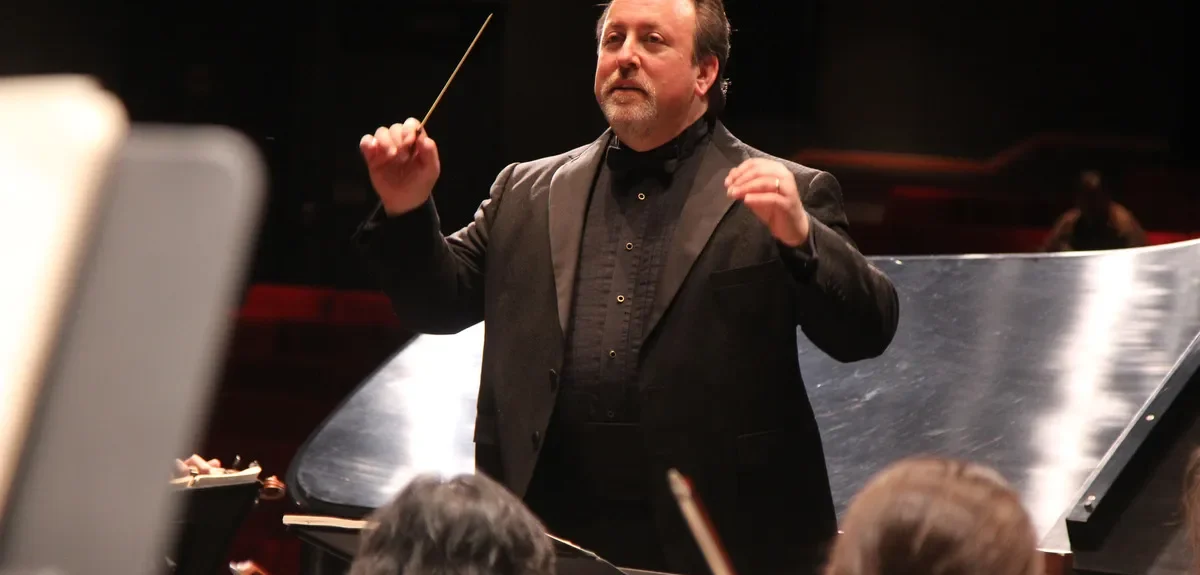By Judy Harrison.
Gustav Mahler’s Symphony No. 5 in C-sharp minor is a marathon for any orchestra. It takes 68 minutes to play its five movements, nearly twice as long as it takes an orchestra to play Ludwig van Beethoven’s fifth symphony.
The piece, performed Sunday by the Bangor Symphony Orchestra at the Collins Center for the Arts in Orono, required 74 musicians, more than the 56 on stage for the opening concert in October or the 49 used for the phenomenal January performance that wove a tapestry of sound out of new and old music. Mahler’s symphony required hiring extra musicians in almost every section.
Under the baton of Lucas Richman, the musicians flooded the Hutchins Concert Hall with sound that pinned concertgoers to their seats while a wind and rain storm forced rivers and streams over their banks outside. Titled “Mahler’s 5th: From Darkness to Light,” the concert was a triumph for the musicians, who hailed from Maine and away. The audience rose to its feet and cheered the precision and passion with which they performed.
Mahler wrote the symphony in the summers of 1901 and 1902 at his summer villa in Austria, according to the program notes. He was the conductor of the Vienna Opera at the time, and summers were the only time he could devote to composing. It is described as “an epic progression from grief and sorrow to overwhelming joy.”
The symphony was written so that every section of the orchestra gets to play what is, in essence, a solo. It was as if Mahler was taking the audience on a tour of the orchestra in a much more sophisticated and epic way than Benjamin Britten’s “The Young Person’s Guide to the Orchestra” does.
The concert began with a short piece, Masonic Funeral Music in C minor, by Wolfgang Amadeus Mozart. It was written as a memorial to two of the composer’s fellow Masons, who both died in 1785. Mozart ended the piece with a major chord. At the time it was considered to be highly unusual, if not unheard of, to end a composition written for in a minor key with a major one and vice versa. It was sort of like when folk singer Bob Dylan went electric.
Richman told the audience Sunday that a major key was considered hopeful and happy while a minor one represented sadness and sorrow. The major and minor keys also represent light and darkness respectively, the maestro said. Mahler’s symphony also began in a minor key and ended in a major one.
The ending of the Mozart piece was marred Sunday when a concertgoer’s cell phone rang despite a recorded reminder before the performance began to turn them off. Please triple check to make sure those ringers are off next time.
Under Richman’s guidance since he arrived in 2010, the maestro has helped the orchestra transition from being the oldest, continuous community orchestra in the nation to a professional entity. That the musicians successfully and beautifully interpreted the musical marathon is proof his hard work truly is paying off and audiences are reaping the rewards.
The Bangor Symphony Orchestra’s final concert of the season, “Paths to Dignity: The Music of Lucas Richman” will be performed at 3 p.m. April 28 at the Collins Center for the Arts at the University of Maine in Orono. For information, visit bangorsymphony.org or call 207-942-5555.
Photo: Lucas Richman, conductor of the Bangor Symphony Orchestra. Photo Credit: Jeff Kirlin / Bangor Symphony Orchestra
